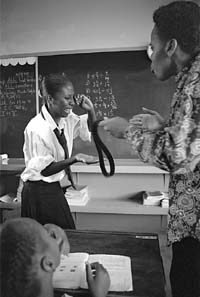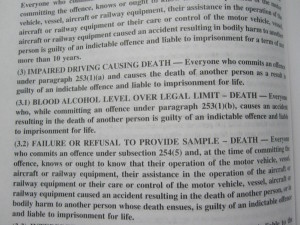Caught Up in the System: For Empowerment, Challenging Child Protection Institutions Is Not Enough
 Something has been happening in the child protection system in Toronto; it has a racial dynamic.
Something has been happening in the child protection system in Toronto; it has a racial dynamic.
Reports have revealed that although blacks or African Canadians are only about 4% of the Ontario population, and just 8% of Toronto’s population, they represent about 41% of all the children and youth in the care of the Children’s Aid Society of Toronto [“CAS”][1], the agency with the responsibility for intervening when a child in the community is “in need of protection” as a result of physical harm, sexual molestation or exploitation, abandonment, neglect and other harms or risks created by or resulting from parents or caregivers.[2]
Put another way, blacks are found in the care of the CAS at 5 times[3] or 400% of their representation in the Toronto population.
A more recent report posits that black children in Toronto remain in foster and group homes longer than any other group of children.[4]
This data suggests that deeper analyses of the child protection system are required, particularly examinations of structure and values which may be producing unjustified, adverse impacts on black children and parents in connection with how readily agencies investigate them and how long it takes to be free of supervision and control.
Respectfully, however, American evidence that blacks are investigated twice as often as whites when a report is made to child welfare authorities[5], and that “[m]ost white children who enter the system are permitted to stay with their families, whereas most children of African descent are taken away from theirs”[6], combined with the underdevelopment of more involved statistical analysis about the Ontario and Torontonian child protection systems, strongly suggests that all families with children, and black families with children in particular, need to at least consider the legal realities and factors within their own control that contribute to creating the risk of being ensnared in the that system. These factors and legal ground rules include, but are not limited to, the following:
A. In Canada, as a starting point and at its legal core, physically disciplining your child is assault. In basic terms, assault[7] is
- applying force – i.e. hitting, striking,
- intentionally – i.e. a deliberate action done consciously, not by accident or as a reflex,
- directly or indirectly – i.e. the force can be applied directly from the hitter’s body (e.g. hands directly contacting the recipient’s face) or indirectly through an intervening object (consider the act of literally slamming a door on someone where the slamming force is directly applied to the door and indirectly applied to the person getting slammed on),
- without the consent of the person being hit – i.e. the person being hit never gave voluntary or uncoerced, informed permission for you to hit her/him.
Essentially, every instance of spanking, “licks”, paddling, a “beatin’” or a “smack” will satisfy the criteria for proving assault.
B. While physically disciplining a child effectively amounts to assault, Canadian law provides parents with a limited immunity from criminal responsibility when that assault is for
- Corrective purposes and is
- Carried out reasonably in the circumstances.
Section 43 of the Criminal Code of Canada, interpreted in a 2004 case decided by the Supreme Court of Canada[8], the court with the most authority in the country and whose legal rulings contribute to the law all Canadians must follow, provides this limited insulation from being criminally responsible for assaulting a child because the Court acknowledged that “minor disciplinary contact” can have a role to play for parents obliged to deliver “safety and security” to their children in “an age-appropriate manner.”[9]
C. “Corrective purposes” has specific meaning. In Canadian law, immunity from being responsible for assaulting your children when delivering physical discipline is reserved for those who take a more thoughtful approach that is calculated and measured to address the behaviour in question, with a child that is capable of digesting the educational message that the physical discipline is supposed to deliver. Generally, physical discipline is not considered “corrective” if it is
- An anger-motivated assault,
- A frustration-activated assault,
- Delivered to a child too young to understand the educational message of the physical discipline (and accordingly too young for that discipline to be successful in anything but the short term), or
- Delivered to a child mentally unable to learn the educational message, perhaps due to developmental delay, etc.[10]
Discipline with these features is not considered corrective and destroys the immunity parents have to physically discipline their children. As a general guide and in broader terms, physical discipline will tend to be considered corrective and educational only when it is
- delivered by a clearheaded parent who has
- considered the discipline in a rational and logical manner and
- directed that disciplinary force at the actual behaviour creating the concern while
- designing that physical discipline to restrain or control the problematic behaviour or to express symbolic disapproval of that behaviour.
D. In Canada, “only the mildest forms of assault” will be considered reasonable as physical discipline. Reasonableness is future-oriented and assesses whether physical force used for correction makes objective sense for successfully shaping future behaviour. Reasonableness does not focus on the level of seriousness of the child’s past “bad behaviour” because this improperly invites parents to be punishing and harsh, not enlightening and educational. There are some clearly expressed situations in which physical discipline, even if fully and honestly intended for a corrective/educative purpose, will never be considered reasonable because “comprehensive and consistent”[11] expert social science evidence and “social consensus” (not the personal beliefs of individual parents) in the international community (particularly among western and European nations) relevant to child behaviour, welfare and development establishes the critical connection between particular circumstances of physical discipline and tangible harm and degradation to children.
Physical disciplinary force is unreasonable if it
- Causes bodily harm (i.e. more than low-level, very short-lived harm),
- Creates the reasonable possibility of bodily harm (i.e. just because bodily harm didn’t actually result from the force used, if that force, from an objective view, could have created bodily harm it is unreasonable),
- Is used on a child younger than 2 years old (because she can’t understand the corrective message supposedly embedded in being hit),
- Is used on a child 13 years of age or older (because, as a teenager, it harms her by promoting aggressiveness and anti-social behaviour),
- Delivered with an object, such as a belt or a ruler (because it causes physical and emotional harm),
- Delivered to the head area (because it’s harmful or objectively could be), or
- Delivered by a teacher (except where a child must be removed from a classroom or controlled to follow instructions and, even then, it is rarely reasonable).
E. Child protection agencies have a prime directive: protecting the best interests of the child.[12] Protecting the integrity of the family unit or promoting the best interests, beliefs, cultural practices and/or philosophies of the parent engaged is not their ultimate concern.
F. Child protection agencies do not require the strongest evidence to start an investigation about an allegation of child abuse (including excessive physical discipline) or to initiate intervention. Child protection files can be opened to proceed in family court without the kind of proof that would be required to prove guilt at a criminal trial as long as the agency receives enough evidence to have reasonable grounds to suspect that a child (a person aged 15 or younger) is “in need of protection”.[13] If parents believe that the CAS or analogous agencies need proof close to absolute certainty or proof beyond a reasonable doubt before injecting themselves into their family life, then those parents, to their detriment, are mistaken.
G. Parents should be alive to the possibility that child protection workers, often registered as social workers and social service workers with obligations to keep current with relevant social science studies, are aware of and influenced by the academic research that indicates a preference within certain ethno-cultural or national-origin communities for corporal punishment or physical discipline.
For example, beyond anecdotal evidence, a body of research addresses the role of physical discipline in Jamaican families.[14] Among other things, it discloses the following:
- Over the last 50 years several studies have examined the “socialisation process with a strong focus on the form of discipline used by Jamaican parents or caregivers”[15];
- Corporal punishment is “considered to be the most prominent discipline style in Jamaican society”;[16]
- Some researchers have noted that Jamaican caregivers’ methods are “physically abusive, repressive, harsh and psychologically damaging for children”;[17]
- “caregivers, being restrictive, demanding and negligent of children’s emotions, perspectives and preferences, interact and communicate with children in an authoritarian manner”;[18]
- “One of the key characteristics of the authoritarian approach that is commonly adopted by Jamaican caregivers across all socioeconomic strata is the endorsement of, and commitment to, the use of corporal punishment, which they see as an appropriate and justified method of discipline”;[19]
- “In the Jamaican context” this authoritarian “approach to parenting constitutes ‘beating or flogging’, which involves children being beaten with objects (e.g., tamarind sticks, rulers, belts, pieces of board, garden hose) and/or kicked for engaging in undesired behaviour such as lying, stealing, being disobedient or impolite, failing to complete chores, crying and refusing to eat”;[20]
- “Corporal punishment has been linked to a range of negative outcomes in Jamaican children, including conduct disorder, suicide ideation, depression, higher use of alcohol and illegal drugs, impulsivity, aggression, anxiety and a decrease in parent–child interaction and connectedness”;[21] and
- “[S]ome Caribbean parents who have migrated to the United States struggle to reconcile their cultural beliefs about disciplining with Western laws and ideas concerning proper methods of discipline.”[22]
Arguably, it lacks good sense to gloss over the idea that child protection workers might consider these propositions in their frontline work. The fact that 23% of the black families “served” by the CAS in Toronto are led by caregivers who were born in Jamaica raises the volume on the argument.[23]
It’s rational to be troubled by statistics which appear to confirm the institutional discrimination one may have sensed for a long time. It is unproductive though to abandon agency in favour of a single-barreled approach that only waits for government authorities to consult and act.[24]
In this case, it is possible and, in fact, beneficial to multi-task.
The communities impacted by child protection agencies should expect to be heard and to see change because government authorities can have baked-in approaches reflective of their express and unstated beliefs which yield discriminatory results for those historically disadvantaged (for example, low income black women with limited education living in difficult neighbourhoods).
At the same time, within a Canadian child protection context that cannot be analysed or reformed quickly and is not certified as discrimination-free, practicality demands that parents actively seek, engage and empower themselves with the information that can aid them in reducing the chances of state intrusion into their families.
______________________________________________________________________________________
Notes:
[2] Child and Family Services Act R.S.O. 1990, c. C.11, ss. 15 and 37 (http://www.ontario.ca/laws/statute/90c11#BK54)
[4] http://www.thestar.com/news/cas/2015/08/26/black-kids-stay-longest-in-care-cas-study-shows.html
[6] Id.
[7] s. 265, Criminal Code of Canada
[8] Canadian Foundation for Children, Youth and the Law v. Canada (Attorney General), 2004 SCC 4 [“Canadian Foundation”]
[9] Canadian Foundation at para. 50
[10] Canadian Foundation at para. 24
[11] Canadian Foundation at para. 2
[12] Child and Family Services Act, R.S.O. 1990, c. C.11, s. 1 (1): “The paramount purpose of this Act is to promote the best interests, protection and well being of children.”
[13] Child and Family Services Act, R.S.O. 1990, c. C.11, ss. 37(2) and 72(1)
[15] Id.
[16] Arnold, E. (1982). The use of corporal punishment in child rearing in the West Indies. Child Abuse and Neglect, 6(2), 141–145. doi: 10.1016/0145- 2134(82)90006-0; Brown, J., & Johnson, S. (2008). Childrearing and child participation in Jamaican families. International Journal of Early Years Education, 16(1), 31–40. doi: 10.1080/09669760801892110.
[17] Arnold, E. (1982), Id.; Barrow, C. (2010). Caribbean childhoods “outside” “adopted” or “left behind”: Good enough parenting and moral families. Kingston, Jamaica: Ian Randle; Smith, D.E., & Mosby, G. (2003). Jamaican child-rearing practices: The role of corporal punishment. Adolescence, 38(150), 369–381.
[18] Ricketts, H., & Anderson, P. (2008). The impact of poverty and stress on the interaction of Jamaican caregivers with young children. International Journal of Early Years Education, 16(1), 61–74. doi: 10.1080/09669760801892276; Smith, D.E., & Mosby, G. (2003), Id.
[19] Brown, J., & Johnson, S. (2008). Childrearing and child participation in Jamaican families. International Journal of Early Years Education, 16(1), 31–40. doi: 10.1080/09669760801892110.
[20] Arnold, E. (1982) at note 9; Barrow, C. (1996). Family in the Caribbean: Themes and perspective. Kingston, Jamaica: Ian Randle; Smith, D.E., Springer, C.M., & Barrett, S. (2011). Physical discipline and socioemotional adjustment among Jamaican adolescents. Journal of Family Violence, 26(1), 51–61. doi: 10.1007/s10896-010-9341-5.
[21] Crawford-Brown, C. (1999). The impact of parenting on conduct disorder in Jamaican male adolescents. Adolescence, 34(134), 417–436; Smith, D.E., Springer, C.M., & Barrett, S. (2011), Id.; Ricketts, H., & Anderson, P. (2008) at note 11.
[22] Baptiste, D.A., Hardy, K.V., & Lewin, L. (1997). Clinical practice with Caribbean immigrant families in the United States. The intersection of emigration, immigration, culture and race. In J. Roopnarine & J. Brown (Eds), Caribbean families: Diversities among ethnic groups (pp. 275–303). Greenwich, CT: Ablex.
[23] http://www.thestar.com/news/cas/2015/08/26/black-kids-stay-longest-in-care-cas-study-shows.html
[24] http://www.oacas.org/what-we-do/government-and-stakeholder-relations/one-vision-one-voice/#tab-2
Photo Source: http://www.corpun.com/jms00106.htm






